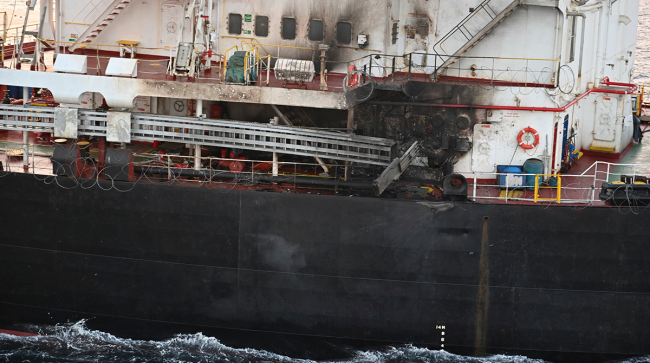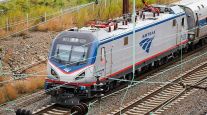Senior Reporter
House T&I Presses White House to Safeguard Supply Chain

[Stay on top of transportation news: Get TTNews in your inbox.]
House transportation policymakers renewed calls for the Biden administration to enhance its response to growing supply chain concerns.
Members of the chamber’s supply chain caucus recently pressed top administration officials to continue to address ongoing attacks credited with disrupting international shipping routes.
“While the Biden administration has taken action to confront these attacks, violence and disruption persists,” Reps. David Rouzer (R-N.C.), Dusty Johnson (R-S.D.), Colin Allred (D-Texas) and Angie Craig (D-Minn.) wrote to the secretaries of State, Defense and Transportation on Jan. 30.
“Approximately 20% of all container shipping passes through the Red Sea and Suez Canal, making any disruptions in that region of particular concern to shippers and customers alike,” the lawmakers went on. “Rerouting ships also results in lengthier shipping times — 10 days of travel time on average — further exacerbating delays.”
"Permitting delays are stifling important infrastructure projects across the country."
Read about Water Resources & Environment Subcommittee Chairman @RepDavidRouzer's bill to establish much-needed consistency & certainty in the nationwide permit process: https://t.co/HF0AmpUWXA — T&I Committee Republicans (@TransportGOP) January 19, 2024
At issue for the lawmakers are Iran-backed Houthi militants linked to aggression and attacks on commercial ships in the Red Sea. For a couple of weeks, U.S.-led airstrikes have targeted the Houthis, whose leadership explained its attacks respond to military conflicts in the region.
At a transportation committee hearing on Jan. 30, Rouzer, chairman of the Water Resources and Environment Subcommittee, further emphasized: “I have heard from industries all across the board — obviously — just how critically important the Red Sea and Suez Canal are to an efficient supply chain.”
Rep. Daniel Webster (R-Fla.), Coast Guard and Maritime Transportation Subcommittee chairman, joined GOP colleagues in calling on the administration to continue its work to guarantee the safe arrival of goods at national ports of entry.
“At the same time these disruptions are occurring in the Red Sea, the Panama Canal is also facing bottlenecks as low water levels are forcing canal authorities to reduce transits by half — compounding uncertainty for ocean carriers and shippers,” Webster said at the hearing, noting reduced water levels in the Panama Canal due to drought conditions.
Shippers are already in a rush to move goods before Chinese factories shut down for the Feb. 10-17 Lunar New Year holiday. So lower water levels in the Panama Canal leaves them to consider crossing the Pacific to West Coast ports and move the goods across country by truck or train.
“We saw firsthand during the pandemic what a significant supply chain crisis can do to the global economy, and we must not let it happen again,” Webster added.
The Houthi attacks in the Red Sea are threatening the global supply chain.
We may not be able to part the Red Sea like Moses, but we must work to secure the shipping lanes in the Red Sea, or Americans and consumers around the world will pay the cost. https://t.co/B73BoyRhqz — Rep. Dusty Johnson (@RepDustyJohnson) January 30, 2024
For senior Democrats, safeguarding commercial transportation corridors remains an ongoing priority that the administration is pursuing for the economy and the freight workforce. Rep. Salud Carbajal (D-Calif.) highlighted the military presence in the Red Sea and affirmed Congress “must find new and innovative ways to bolster the U.S. merchant marine.”
Rep. Rick Larsen (D-Wash.), the panel’s ranking member, offered a forward-looking perspective on supply chain investments. “While we cannot control the rain in Panama, Congress can ensure that our infrastructure here at home works.”
"That means continued investment in roads, rail, airports, ports, vessels and the women and men that make transportation work," Larsen told colleagues during the hearing. “It’s not too soon to start considering what that next investment in infrastructure and the U.S. maritime industry will look like.”
How does hydrogen fuel cell technology fit into freight transportation? Find out with Parker Meeks, the CEO of Hyzon, a company that designs and manufactures fuel cell technology for heavy-duty transport applications. Tune in above or by going to RoadSigns.ttnews.com.
Stakeholders offered insight and perspective during the hearing. Jonathan Gold, vice president of supply chain and customs policy with the National Retail Federation, argued the supply chain landscape would benefit from continued attention to the Red Sea.
“We know the future impacts that will result from ongoing disruptions. While we are addressing the immediate issues impacting transit through the Red Sea and Suez Canal, we need to make sure we are preparing for the congestion issues that will impact U.S. ports in the coming months,” Gold said.
Bud Darr, executive vice president for maritime policy and government affairs at MSC Group, pointed to efforts designed to improve the supply chain, such as the U.S. Department of Transportation’s Freight Logistics Optimization Works, or FLOW, program.
Want more news? Listen to today's daily briefing above or go here for more info
“I want to congratulate the Department of Transportation for initiating the FLOW process, which is a pretty good attempt to try and open up some more visibility with the hope that we can project forward patterns much better based on the past. And it’s an example of a genuine public-private partnership that I think deserves some recognition,” Darr told the committee.
According to the Bureau of Transportation Statistics, motor carriers involved in the FLOW program include: C&K, Gulf Winds, IMC Companies, NFI Industries, RoadOne and Werner Enterprises. Specifically, the bureau explained the FLOW program “measures the nation’s cargo traffic demand against infrastructure and equipment supply, leading to a novel approach to optimize the use of supply chain assets. USDOT works with freight stakeholders to aggregate and identify demand forecasts of containerized freight volume and to provide timely and accurate asset supply at system nodes.”
Last year, the administration announced the launch of the Office of Multimodal Freight Infrastructure and Policy. The office is responsible for maintaining and improving the condition and performance of the nation’s multimodal freight network.





